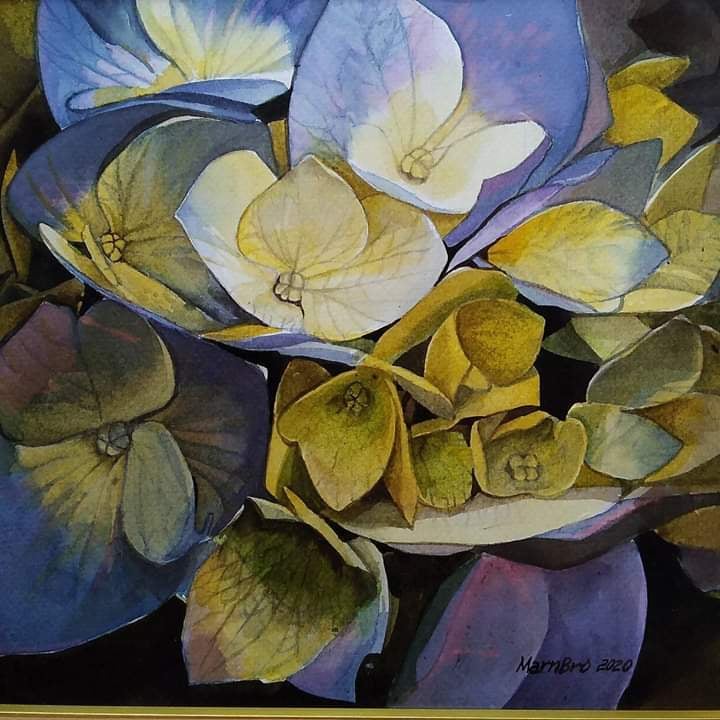Marvin Tiberio, 42, isn’t a full-time artist. He’s an ordained pastor of 18 years at the Church of Nazarene in Mati, Davao Oriental.
As if that wasn’t surprising enough, the unsuspecting paintings you see above, are also made of “organic paints” specifically, the black fluids from gutted squid or pusit.
A Fine Arts major at the Far Eastern University in Manila, the pastor-painter dropped out of his track because he was struggling to buy art supplies. But more importantly, god came calling.
Tiberio has reached a level of fame online in the past week after nearly a decade spent experimenting with organic paints as an alternative to their commercially available and pricier counterparts.
“I posted a short encouragement to an online artists’ community, after hearing their frustration about expensive art materials, I thought I would share what I’ve been doing,” Tiberio said.
“I believe there are many naturally talented visual artists out there who are intimidated with the price of painting materials who cannot market their art. That shouldn’t stop them,” he added.
Coconuts Manila chatted with the watercolorist about how tricky his process is, his journey as a struggling artist, and his true feelings for pusit.
The following interview responses have been lightly edited for brevity and clarity.
Besides squid ink, what other organic paints do you use?
I’ve experimented on many organic paints, to test for color durability, fading, consistency, and if I can manipulate them. But apart from squid ink, what stands out are these three: turmeric, atsuete (annatto), and blue ternate [flower]. I also recently discovered and am experimenting with the mirabilis jalapa flower. But my base color is squid ink. My process is layering. Instead of mixing the paints, I put the squid ink to build up my base image then follow it up with any organic color.
Squid ink is stronger than watercolor, it will not be washed out if you soak the finished painting in water for long hours.
I’ve also tried using tree bark or sawdust for red coloring. I also used lemon juice to coax out different colors, because I discovered that blue ternate reacts to lemon acid, and it creates a purple color as a chemical reaction. Here’s an example of that.

How tricky is it to work with squid ink? Do you need to work fast in case it expires? Does it stink?
It doesn’t stink. Well… it stinks a little bit when you’re working with the ink. But when it dries it doesn’t stink anymore. It isn’t really difficult to work with the smell. I’ve grown to enjoy it, and I prefer this to smelling fumes from oil, acrylic, and enamel paints.
In the case of the colorant, you have to use it right away before it turns brown.
Not many people have thought of the idea, do you think it’s because using commercial paint is easier?
Yes, but at the same time, I’d like to point out that I did not discover or invent the use of organic paints.
I just want people to remember how artists use available colors in nature in the past without the aid or mass production of modern colors. Ancient writers in Egypt use squid inks to write, even [Leonardo] Da Vinci, I think, uses squid inks for some of his sketches.
How much squid do you need for one painting?
It depends on the size of the painting, and the saturation of the tones. One kilo of squid will paint half of a 4 x 8 feet painting. My painting size varies and the biggest one so far is 22 x 28 feet.
https://www.facebook.com/matibaiblog/photos/pcb.1680187892134585/1680183765468331/?type=3&theater
You’re an ordained pastor, but how long have you been painting, with both organic and synthetic paints?
I’ve always been drawn to art. Since I was 5, I first learned to draw before I could even learn to write. I also enjoyed teaching myself paintings as a kid from art sign shops way back when there were artists who would do posters for cinemas, which I would observe. I studied it in college at the FEU in Manila before I left to be a pastor. Yes, I’ve been a pastor for 18 years. But I started experimenting since August 2013. I sold my first painting to a friend in California. When someone saw what I was doing they told me to do more, and it was in 2016 where I started producing more paintings.
Before that, I was a watercolorist. Ever since I was a kid I remembered that squid ink left stains, so I thought of applying that in my watercolor because I had a difficult time buying art materials.
How huge is the difference in price? How much are you able to save with squid ink?
A lot. One good brand of watercolor is worth PHP1,000 (US$20) to PHP5,000 (US$100), whereas pusit is worth up to PHP300 (US$6) per kilo. I use pusit or the cheaper squid instead of cuttlefish or escohido, which is the more expensive kind. Because the other two produce too dark colors. But pusit gives off a nice sepia color.
Do you use other tools besides a paintbrush?
I use toothbrush [on the painting below] for effect. I’ve also used salt, crumpled paper, a strainer, tissue, sandpaper, whatever is available that I can use that would apply the intended painting effect I want to achieve.
Do you remember how much your first painting sold for, and how much do your paintings fetch for now?
My first painting sold for US$100 back in 2016, the buyer set the price. Today, I put the price range on my paintings from PHP1,000 to PHP8,000 (US$160). But most of the paintings bought are based on the client’s pricing. I’ve been able to support my family and five kids, and raise money to support my ministry through these paintings.

Who and what inspires you to paint?
Current events, sometimes after watching documentaries, biblical insights. I love to paint people first and foremost, then nature such as flowers and landscapes. With art influences, I’m inspired by Caravaggio, John Singer Sargent, Norman Rockwell, Boris Vallejo, Monet. I’m inspired by them, if not by their art, then their stories.
What do you consider your greatest work?
The painting of my mother before she had a stroke.

It’s beautiful. On a lighter note, we’re guessing you eat the squid after you’re done gutting it for ink. Do you ever get fed up eating it?
I’ve actually learned to cook a lot of dishes with squid. My family didn’t enjoy eating it at first, but I’ve since added it to my dish repertoire and they enjoy eating it: crispy adobo, dried then fried, grilled, cooked as calamari, sometimes stir-fried with leafy vegetables. Squids are a great blessing.
Read more Coconuts Manila articles here.




